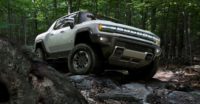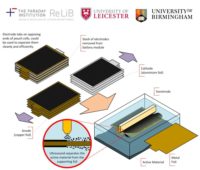Magna International Inc. is a leading Tier One supplier that serves automakers around the world. The $38 billion Canadian company produces a broad portfolio of products that include advanced driver assistance systems, body and chassis structures, electronics, exterior mirrors, front-end modules, mechatronics, power train components and seating. Through its Magna Steyr division in Graz, Austria, it’s also the largest contract manufacturer in the auto industry.
Recently, Magna has become a major force behind electric vehicles, producing a variety of axles, drives, inverters, motors and other components. For instance, its new eDS Mid is a compact, high-speed e-motor that offers a scalable power range from 100 to 140 kilowatts, optimized for 800 volts for electric all-wheel drive applications.
In addition, Magna builds battery enclosures. The structures house high-voltage batteries, electrical components, sensors and connectors. They contribute to the structural and safety aspects of EV frames while also protecting sensitive battery components from potential impact, heat and water intrusion.
“The accelerating shift toward vehicle electrification opens up exciting growth opportunities for [us] beyond power train,” says John O’Hara, president of Magna’s body and chassis group. “We have been able to leverage our expertise to supply battery enclosures—a product for which we see strong potential going forward.”
Magna was recently selected by General Motors to supply battery enclosures for the 2024 Chevy Silverado EV. That order piggybacks on a similar product that it already produces for the GMC Hummer EV.
The battery enclosure for the latter vehicle is made from 139 individual stamped-steel components that are joined together with more than 3,000 welds. It includes stiffening ribs to increase torsional rigidity, which is important for tackling tough off-road terrain. The large structure holds a battery pack that consists of 24 modules of pouch cells that weigh 2,800 pounds.
Magna currently has five factories worldwide that produce battery structures for startup and legacy OEMs, with several other facilities in the pipeline. The enclosures for the GM pickup trucks are mass-produced at the two-year-old Magna Electric Vehicle Structures assembly plant in St. Clair, MI.
Autonomous & Electric Mobility recently asked John Johnson, executive director of product development at Magna, to talk about battery enclosures and the state-of-the-art assembly facility.
AEM: Why are battery enclosures important to electric vehicles?
Johnson: Lithium-ion batteries are dangerous, but enclosures carry modules and packs securely. The structure is there to protect the vehicle and its occupants during any kind of safety event. It also protects batteries from dust, mud, moisture, snow and water.
Precision is the key when it comes to making this complex automotive subsystem that requires intricacy and high standards of craftsmanship. It’s like bringing the demands of making a Swiss watch into a part that can be larger than a kitchen table.
But, unlike a timepiece or a clock, consumers may never see the battery enclosure because it is hidden on the underside of the vehicle. Most importantly, the battery enclosure is a critical element of every EV, contributing to the structural and safety aspects of the vehicle and protecting high-voltage batteries from damage.
While battery enclosures are unique to EVs, there are some similarities to structures used in ICE vehicles, such as fuel tanks. The same basic kind of engineering skills are important—we have to design structures that address durability and can withstand crash loads. Traditionally, a body in white has to be leak tight, but the tolerances on battery enclosures are much more stringent.
AEM: What is the latest trend in EV battery enclosures?
Johnson: There’s been some study of various types of structures and materials. But, none of the OEMs truly has a great direction yet. Most are still trying to find their way. Engineers are looking for the right fit for the type of vehicle they’re working on. There’s no one-size-fits-all solution today. Enclosures tend to be specific to individual vehicles. Each OEM has different requirements, depending on the size of the vehicle. Some battery enclosures must be lightweight, so automakers are willing to invest in more expensive designs or materials. Other platforms focus less on mass and more on cost, so they’ll stick with less expensive steel architectures.
AEM: How have battery enclosures been evolving?
Johnson: Today, battery trays are getting larger, which adds extra weight. But, the technology we’re introducing is making them more efficient. We’re also using more mixed materials. Some trays use hot-stamped steel for high strength. We have other trays where we incorporate castings as needed for complexity. We marry them up with extrusions for the long linear structure. We’re seeing more and more architectures where we’re able to bring that efficiency into the mix a little bit better than in the past.
However, there’s still a lot of variance among automakers and no real standards. The internal structure is defined by the type of battery module architecture that’s being used. For instance, cylindrical batteries have a different structure than pouch cells, which are typically housed in rectangular modules.
AEM: What makes Magna’s battery enclosures unique or different?
Johnson: Our expertise and innovative processes enable battery enclosures to be developed in steel, aluminum and multimaterial configurations, including lightweight composites, to meet the individual needs of each OEM. Because of our ability to adapt to customer requirements, Magna is widely regarded as a technology leader in the shift to electrification.
Magna’s full systems approach, in-depth product expertise and complete vehicle knowledge enable us to see the big picture and deliver the innovations that drive the future of mobility. We have our eye on the future, further evolving the design and integration of battery enclosures into the structure of vehicles.
The technology we bring to the assembly of the components is what sets us apart. We have a lot of material know-how that we bring to the table. We also provide years of experience working in chassis and body structures.
AEM: What role do new materials and new production processes play in your battery enclosures?
Johnson: No matter what material we pick, mass is always important to EV range. The lighter you can make it, the farther the vehicle can go on a charge. We’re looking at next-generation materials, such as Gen3 high-strength steels, to achieve the lightest weights that are possible.
Our design for the Hummer requires 75 meters of sealant and more than 4,800 welds. We’re using artificial intelligence and advanced vision technology to ensure that the correct amount of adhesive is being applied in the correct location. We also use AI tools to ensure that welding seams are at the right quality level.
The AI system automatically takes a photo of each weld or sealant bead and is constantly in a learning mode, which enables it to get smarter and smarter over time. It’s a very repeatable process that allows us to deliver consistent quality.
AEM: How does the St. Clair assembly plant approach manufacturing?
Johnson: It’s our first facility that is purely dedicated to producing battery enclosures. The plant currently contains 345,000 square feet of space, but we’re in the process of building a 740,000-square-foot addition.
We make two versions of the steel battery enclosure for the Hummer EV designed to fit the short- and long-wheelbase versions of the truck. Both are packed with parts, including stampings, roll-formed components and fasteners. The integration and assembly of all these components into such a large assembly held to millimeter-level tolerances is a challenge that we have overcome.
We build both the lower and upper tray, plus the cover. In addition to the battery housing, we make shear plates that connect the structure to the front and rear chassis subframe and provide all-around protection. We have two lines for the shear plates and two lines for the battery enclosures.
We currently use 48 laser welders and 350 robots to assemble enclosures. Robots play an important role in material handling, because we use some large metal parts that are more than 2 meters long. And, a completed enclosure weighs 441 pounds.
The facility is highly automated; we don’t do any type of manual welding. Everything is primarily laser and spot welded. We don’t do any riveting, but we do install lots of fasteners, such as clinch nuts. Every tray is also 100 percent leak tested to ensure tightness.
AEM: How will the new addition improve your facility?
Johnson: The addition will be enable us to ramp up production for the Chevy Silverado and will give us the ability to build products for additional vehicle platforms. We are currently in the process of fine-tuning the assembly lines. The expansion will be ready sometime in 2024. We currently don’t form any components in the facility, but we will with the new addition.








